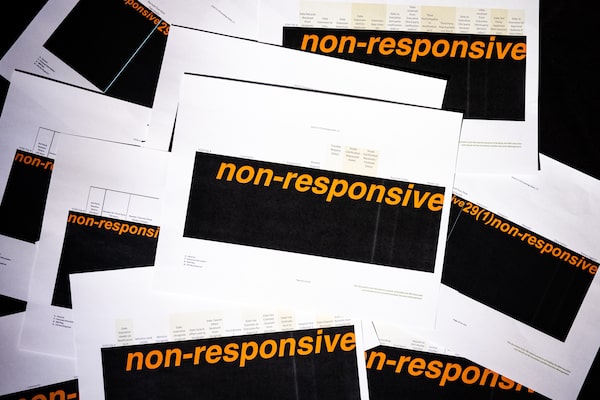
For its Secret Canada project, The Globe and Mail sent freedom of information requests to government departments and ministries in every federal, provincial and territorial jurisdiction. Many came back with redactions, like these ones from Saskatchewan’s Ministry of Highways.Melissa Tait/The Globe and Mail
David Walmsley is editor-in-chief of The Globe and Mail.
Transparency is a crucial pillar of democracy: the public has a right to know how decisions are being made, and by whom, at all levels of government.
And yet, so much of that information is inaccessible, either because governments have declared it off-limits, or because they have failed to invest in the necessary resources and systems to abide by their legal obligations. Our freedom-of-information systems, binding frameworks to ensure Canadians have transparency, have collapsed under their own weight.
Readers of The Globe and Mail know that we have studied closely the effects of what living in a country of secrecy means. A secret Canada submits her citizens to arbitrary rule, often leaving them in an information abyss.
Take the story of Michael Dagg, a frequent user of the freedom-of-information system. Mr. Dagg was told he needed to wait 80 years for records about a police investigation into federal contracting practices, and died before receiving them.
In an earlier case, Mr. Dagg was told he wasn’t allowed to know the names of certain employees in the Ministry of Finance. That matter, Dagg v Canada, went all the way to the Supreme Court, and a 1997 ruling ordered the names released. Imagine if he had lost.
What Mr. Dagg did was target information he knew existed and pry it out into the open.
In that spirit, and in keeping with our core mission, The Globe is launching Secret Canada, an ambitious project we hope will be a vital resource for all Canadians.
In our campaign to reduce secrecy in Canada, our journalists have created a first-of-its-kind database, found at secretcanada.com, which provides the fullest possible picture of freedom-of-information regimes within the many institutions across Canada that are bound by access legislation.
The website, which will be regularly updated, holds all of the freedom-of-information requests received by multiple levels of government across the country, as well as publicly funded institutions, such as hospitals, school boards, transit agencies and police forces. With a simple search, anyone can discover what public information other Canadians have sought and learn how to access it themselves.
A team led by reporters Robyn Doolittle and Tom Cardoso has been working on the project since October, 2021. In the course of their reporting, they have interviewed more than 200 subject matter experts and filed more than 500 access requests, many of which were denied in their entirety or came back heavily redacted.
The wider team of designers, developers and data journalists includes Ming Wong, Carys Mills, Mahima Singh, Yang Sun, Andrew Saikali and Andrew Louis, along with editors Danielle Webb, Renata D’Aliesio, Matt Frehner, Steve Kupferman, Ibnul Chowdhury and Greg McArthur.
The website is intended as a resource for all, from journalists, lawyers, historians and political researchers to individuals, non-profit organizations and citizen groups. We believe the information contained therein will help offset the deficit of information-sharing that is occurring in part because of the decline in local news coverage.
Our hope is that this transparency will beget accountability, and help to empower Canadians and their communities.
Secret Canada: More from The Globe and Mail
Video: How you can make an FOI request
Investigative journalist Robyn Doolittle has filed many freedom of information requests in her work. Here’s what you need to know about the process.
The Globe and Mail
Podcast: Tom Cardoso and Robyn Doolittle explain Secret Canada
Reporters Robyn Doolittle and Tom Cardoso tell The Globe and Mail’s news podcast about Canada’s broken freedom of information system, and how they spent more than a year and a half investigating its failures. Subscribe for more episodes.
Reader callout: Share your FOI stories
Have you ever filed a freedom of information request in Canada? What was the process like for you? The Globe wants to hear from Canadians about what they've encountered. Share your story below or e-mail secretcanada@globeandmail.com